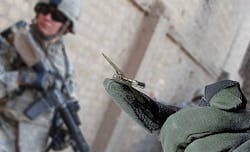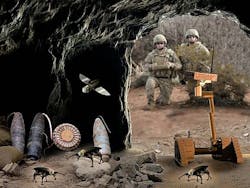BAE Systems to help lead extended Army research to develop battlefield micro robots
MERRIMACK, N.H., 6 March 2013. Micro robot experts at the BAE Systems Electronic Systems sector in Merrimack, N.H., will help U.S. Army researchers develop bio-inspired micro-robotics technology to extend the remote sensing capability of U.S. ground forces under terms of a $43 million contract extension announced Tuesday.
BAE Systems will be among the leaders of extended research efforts for the U.S. Army Research Laboratory in Adelphi, Md., in the Micro Autonomous Systems and Technology (MAST) collaborative program among scientists from the Army, academia, and industry, BAE Systems officials say.
BAE Systems originally won a $38 million MAST agreement with the Army Research Lab in April 2008 to help lead development of next-generation intelligence-gathering military robots with a focus on miniature unmanned vehicles for urban environments and inaccessible terrain.
The $43 million contract extension announced this week will extend BAE Systems MAST work for another five years. BAE Systems is leading the MAST Alliance’s integration team.
Over the next five years the MAST program continues the research, development and integration of several key areas including micro-scale aeromechanics and ambulation; propulsion; sensing, autonomy, communications, navigation, and control; and microscale integration, among others, enabling several different mission-capable robotic platforms.
The MAST Alliance, in addition to BAE Systems includes the Army Research Lab, the Army Research Office, and the NASA Jet Propulsion Laboratory.
Also on the MAST Alliance are the Georgia Institute of Technology; Massachusetts Institute of Technology; University of California at Berkeley; University of California, Merced; University of Maryland; University of New Mexico; University of Sydney; Vanderbilt University ; University of Michigan; University of Washington; Daedelus Flight Systems; and North Carolina A&T.
The MAST program has three technology centers: the integration center, which focuses on microsystem architectures modeling and design tools and experiments; the microelectronic center, which focuses on enabling power efficient multi-functional sensing, ambulatory control, and reconfigurable networked response in mobile micro robots; and the micromechanics center, which focuses on mechanical mobility for small unmanned air and ground vehicles.
The goal of the MAST research is to develop technology for small robots that would be used by individual warfighters for remote surveillance in cities in tough terrain.
"The technologies being developed under MAST will support products that extend soldiers’ capabilities while keeping them out of harm’s way," says Bill Devine, MAST’s strategic development manager for BAE Systems.
For more information contact BAE Systems Electronic Systems online at www.baesystems.com, or the Army Research Lab at www.arl.army.mil.

